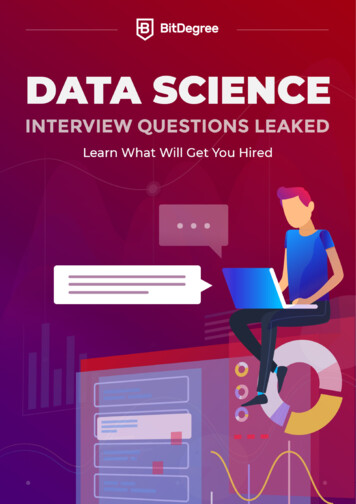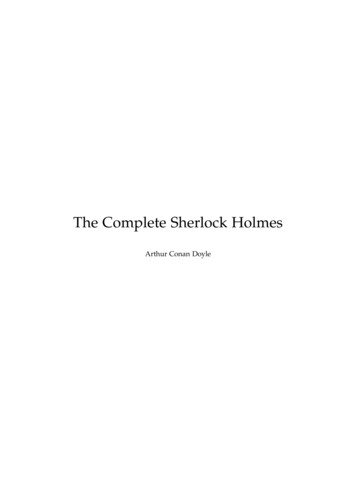
Transcription
1www.bitdegree.org
INTRODUCTIONNaturally, there’s a huge need for qualified data scientistsin the market. The job opportunities for this position areconstantly increasing. So if you’re thinking about applyingfor a data scientist job position, you’ll need to know theessential data science interview questions. This tutorial willprovide you with exactly that.This book is split into two big parts - the basics and themore advanced stuff. Well talk about big data interviewquestions, differentiate data scientists from data analystsand so on. At the very end, I’ll give you a couple of tips tostay cool during your interviews and what people that haveworked thousands of hours in the industry expect frompotential employers.A lot of your early data science interview questions mightinclude differentiating between seemingly similar, yetsomewhat different terms. That’s why it’s probably a goodidea to start from these definitions so that you have a clearunderstanding of what is what moving forward.2www.bitdegree.org
ww.bitdegree.org
1 What is ‘Data Science’?Data science is a form of methodology that is used to extract and organize various data andinformation out of huge data sources (both structured and unstructured).The way that this form of science works is that it uses various algorithms and applied mathematicsto extract useful knowledge and information and arrange it in a way that would make sense andgrant some sort of usage.2 Big Data Vs. Data ScienceSurely one of the more tricky data science interview questions, a lot of people fail to express aclear difference. This is mostly because of a lack of information surrounding the topic.However, the answer itself is actually very simple - since the term ‘big data’ implies huge volumesof data and information, it needs a specific method to be analyzed. So, big data is the thingthat data science analyzes.3 Leaked Interview AssignmentWhat’s the difference between a ‘data scientist’ and a ‘data analyst’?Even though this is also one of the basic data science interview questions, the terms still oftentend to get mixed up.Data scientists mine, process and analyze data. They are concerned with providing predictionsfor businesses on what problems they might come across.Data analysts solve the unavoided business problems instead of predicting them beforehand.They identify issues, perform analysis of statistical information and document everything.4www.bitdegree.org
4 The Core Features ofBig DataNow that we’ve covered the definitions, we can move to the specific data science interviewquestions. Keep in mind, though, that you are bound to receive data scientist, analyst and bigdata interview questions. The reason why is because all of these subcategories are intertwinedwith each other.There are five categories that represent big data, and they’re called the “5 Vs”:1. Value4. Veracity2. Variety3. Velocity5. Volume5 What’s a ‘RecommenderSystem’?It is a type of system that is used for predicting how high of a rating would users give to certainspecific objects (movies, music, merchandise, etc.). Needless to say, there are a lot of complexformulas involved in such a system.6 What’s a ‘Power Analysis’?A type of analysis that’s used to determine what sort of an effect will a unit have simply basedon its size.Power analysis is directly related to tests of hypotheses. The main purpose underlyingpower analysis is to help the researcher to determine the smallest sample size that is suitable todetect the effect of a given test at the desired level of significance.5www.bitdegree.org
7 What’s A/B Testing?While A/B testing can be applied in various different niches, it is also one of the moreprominent data science interview questions. So what is it?A/B testing is a form of tests conducted to find out which version of the same thing is moreworth using to achieve the desired result.Say, for example, that you want to sell apples. You’re not sure what type of apples - redor green ones - your customers will prefer. So you try both - first you try to sell the redapples, then the green ones. After you’re done, you simply calculate which were the moreprofitable ones and that’s it - that’s A/B testing!8 What’s ‘Hadoop’?Hadoop is an open source distributed processing framework that manages data processingand storage for big data applications running in clustered systems.Apache Hadoop is a collection of open-source software utilities that facilitate using a networkof many computers to solve problems involving massive amounts of data and computation.It provides a software framework for distributed storage and processing of big data using theMapReduce programming model.Hadoop splits files into large blocks and distributes them across nodes in a cluster.It then transfers packaged code into nodes to process the data in parallel. This allows thedataset to be processed faster and more efficiently than it would be in a more conventionalsupercomputer architecture.9 What’s a ‘Selection Bias’?Selection bias is the bias introduced by the selection of individuals, groups or data for analysisin such a way that proper randomization is not achieved, thereby ensuring that the sampleobtained is not representative of the population intended to be analyzed.If the selection bias is not taken into account, then some conclusions of the study may not beaccurate.6www.bitdegree.org
10 Define ‘CollaborativeFiltering’?Collaborative filtering, as the name implies, is a filtering process that a lot of recommendersystems utilize. This type of filtering is used to find and categorize certain patterns.Collaborative filtering is a method of making automatic predictions (filtering) about the interestsof a user by collecting preferences or taste information from many users (collaborating). Thistype of filtering is used to find and categorize certain patterns.11 What’s ‘fsck’?‘fsck’ abbreviates as “File System Check”. It is a type of command that looks for possible errorswithin the file and, if there are errors or problems found, fsck reports them to the HadoopDistributed File System.12 What’s a ‘Cross-validation’?Yet another addition to the data analyst interview questions, cross-validation can be quitedifficult to explain, especially in a simplistic and easily understandable manner.Cross-validation is used to analyze if an object will perform the way that it is expected to performonce put on the live servers. In other words, it checks how certain results of specific statisticalanalyses will measure when placed into an independent set of data.13 What’s ‘Cluster Sampling’?Cluster sampling refers to a type of sampling method. With cluster sampling, the researcherdivides the population into separate groups, called clusters. Then, a simple random sample ofclusters is selected from the population. The researcher conducts his analysis on data from thesampled clusters.7www.bitdegree.org
AdvancedInterviewQuestions8www.bitdegree.org
14 Bonus: Possible InterviewExerciseWhich is better - good data or good models?The answer to this question is truly very subjective and case-by-case dependant. Biggercompanies might prefer good data, for it is the core of any successful business. On the otherhand, good models couldn’t really be created without having good data.You should probably pick according to your own personal preference - there really isn’t anyright or wrong answer (unless the company is specifically searching for either one of them).So, do your research about the company. Try to see if they’re testing your knowledge of theirproduct or is it a ‘trick question’.15 Bonus: Possible InterviewExercise 2What’s the difference between ‘supervised’ and ‘unsupervised’ learning?Although this isn’t one of the most common data scientist interview questions and has more todo with machine learning than with anything else, it still falls under the umbrella of data science,so it’s worth knowing.During supervised learning, you would infer a function from a labeled portion of data that’sdesigned for training. Basically, the machine would learn from objective and concrete examplesthat you provide.Unsupervised learning refers to a machine training method which uses no labeled responses the machine learns by descriptions of the input data.9www.bitdegree.org
16 ‘Expected Value’ Vs. ‘MeanValue’?When it comes to functionality, there’s no difference between the two. However, they are bothused in different situations.Expected values usually reflect random variables, while mean values reflect the samplepopulation.17 ‘Bivariate’ Vs. ‘Multivariate’and ‘Univariate’A bivariate analysis is concerned with two variables at a time, while multivariate analysisdeals with multiple variables. Univariate analysis is the simplest form of analyzing data. “Uni”means “one”, so in other words, your data has only one variable. It doesn’t deal with causes orrelationships (unlike regression) and its major purpose is to describe; it takes data, summarizesthat data and finds patterns in the data.18 Bonus: Possible InterviewExercise 3What if two users were to access the same HDFS file at the same time?This is also one of the more popular data scientist interview questions - and it’s somewhatof a tricky one. The answer itself isn’t difficult at all, but it’s easy to mix it up with how similarprograms react. If two users are trying to access a file in HDFS, the first person gets the access,while the second user (that was a bit late) gets denied.How many common Hadoop input formats are there? What are they?One of the interview questions for data analyst that might also show up in the list of datascience interview questions. It’s difficult because you not only need to know the number, butalso the formats themselves.In total, there are three common Hadoop input formats. They go as follows: key-value format,sequence file format and text format.10www.bitdegree.org
19 Bonus: Possible InterviewExercise 4Name a reason why Python is better to use in data science instead of most otherprogramming languages.Naturally, Python is very rich in data science libraries, it’s amazingly fast and easy to read orlearn. Python’s suite of specialized deep learning and other machine learning libraries includespopular tools like scikit-learn, Keras, and TensorFlow, which enable data scientists to developsophisticated data models that plug directly into a production system.To unearth insights from the data, you’ll have to use Pandas, the data analysis library for Python.It can hold large amounts of data without any of the lag that comes from Excel. You can donumerical modeling analysis with Numpy. You can do scientific computing and calculation withSciPy. You can access a lot of powerful machine learning algorithms with the scikit-learn codelibrary. With Python API and the IPython Notebook that comes with Anaconda, you will getpowerful options to visualize your data.Naturally, Python is very rich in data science libraries, it’s amazingly fast and easy to read orlearn. Python’s suite of specialized deep learning and other machine learning libraries includespopular tools like scikit-learn, Keras, and TensorFlow, which enable data scientists to developsophisticated data models that plug directly into a production system.To unearth insights from the data, you’ll have to use Pandas, the data analysis library for Python.It can hold large amounts of data without any of the lag that comes from Excel. You can donumerical modeling analysis with Numpy. You can do scientific computing and calculation withSciPy. You can access a lot of powerful machine learning algorithms with the scikit-learn codelibrary. With Python API and the IPython Notebook that comes with Anaconda, you will getpowerful options to visualize your data.11www.bitdegree.org
GENERAL TIPSThe most important things that you should remember forthe beginning of your job interview are the definitions. If youhave the definitions down and can explain them in an easilyunderstandable manner, you’re basically guaranteed to leave agood and lasting impression on your interviewers.After that, make sure to revise all of the advanced topics. You don’tnecessarily need to go in-depth with each one of the thousandsof data science interview questions out there. Revising the maintopics and simply getting to know the concepts that you’re stillunfamiliar with should be your aim before the job interview.Your main goal at the interview should be to show the knowledgethat you possess. Whether it be interview questions for dataanalyst or anything else - if your employer sees that you’reknowledgeable on the topic, he’s much more likely to consider youas a potential employee.12www.bitdegree.org
essential data science interview questions. This tutorial will provide you with exactly that. This book is split into two big parts - the basics and the more advanced stuff. Well talk about big data interview questions, differentiate data scientists from data analysts and so on. At the very end, I’ll give you a couple of tips to stay cool during your interviews and what people that have .











